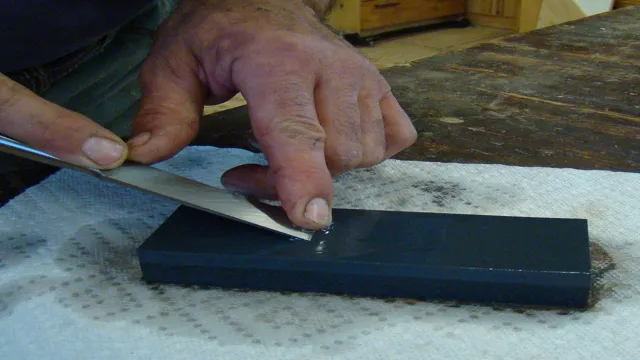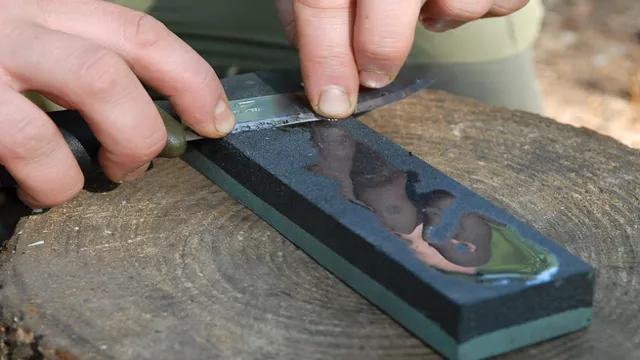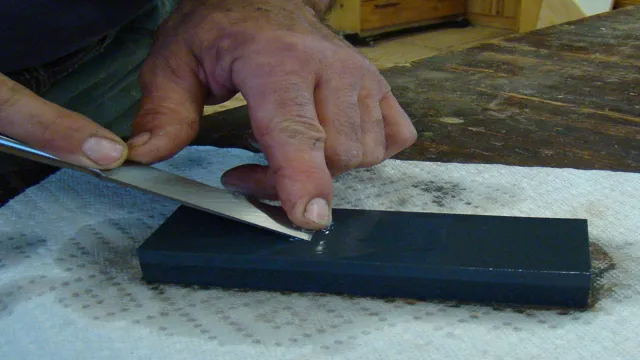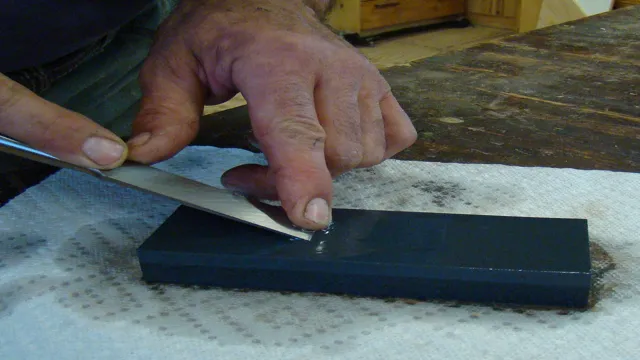How to Use an Oil Stone for Sharpening Chisels: A Step-by-Step Guide

Are you looking to take your woodworking skills to the next level? Are you tired of struggling with dull chisels that refuse to cut cleanly through your wood? If so, then using an oil stone to sharpen your chisels may be the perfect solution for you. Sharpening chisels is an essential skill for any woodworker, and using an oil stone is a tried-and-true method that has been around for centuries. This traditional tool is an excellent choice for those who prefer a hands-on approach and enjoy the satisfaction of achieving a sharp edge through their own hard work.
Using an oil stone to sharpen your chisels is not only cost-effective, but it’s also an environmentally friendly way to maintain your tools. Plus, it requires nothing more than a bit of elbow grease and some patience – two things that every woodworker possesses! With the right technique, an oil stone can provide a razor-sharp edge that will make your woodworking projects a breeze. And who doesn’t want an effortless and seamless experience while working? So, let’s dive into the world of using an oil stone to sharpen chisels and make your workflow better.
Preparing the Chisel
When it comes to sharpening chisels, using an oil stone can be a highly effective method. The first step in using an oil stone to sharpen your chisel is properly preparing it. To begin, ensure that your chisel is clean and free of any debris.
Next, identify the bevel angle of your chisel, which can typically be found on the manufacturer’s website or by using a protractor. Once you know the bevel angle, place your chisel onto the oil stone and hold it at the correct angle. It is important to maintain a consistent angle throughout the process for an even sharpening.
Rub the chisel back and forth on the oil stone using medium pressure, adding more oil as needed. Repeat this process on the other side of the chisel until you achieve a sharp edge. With the proper preparation and technique, using an oil stone can provide a sharp and precise cutting edge for your chisel.
Clean the Chisel
Cleaning the chisel is an essential step in preparing it for use. Whether you’re a seasoned woodworker or just starting out, a clean chisel is crucial for achieving precise and accurate cuts. Before you begin, make sure you have the right tools for the job.
You’ll need a few items, including a wire brush, a honing stone, and some lubricating oil. Start by using the wire brush to remove any debris or rust on the chisel’s surface. Once you’ve removed any loose particles, hold the chisel at a slight angle and use the honing stone to sharpen the blade.
Finally, apply a small amount of oil to the blade to keep it lubricated and protected during use. Taking these steps to clean and sharpen your chisel will ensure that it’s ready for any woodworking project you undertake.

Identify the Correct Angle
When preparing a chisel, it is important to first identify the correct angle for the blade. This will ensure that the chisel cuts cleanly and efficiently, without damaging the surface being worked on. To determine the correct angle, you can use a sharpening guide or a honing guide.
The sharpening guide will help you maintain a consistent angle while sharpening the blade, while a honing guide will help you maintain the angle while honing or polishing the blade. Once you have identified the correct angle, you can use a bench grinder or a sharpening stone to sharpen the blade. It is very important to keep the blade cool while sharpening to avoid overheating and damaging the temper of the blade.
By taking the time to properly prepare your chisel, you can ensure that it will work effectively and last you for years to come.
Flatten the Back of the Chisel
One crucial step in preparing your chisel for woodworking is flattening the back of the blade. This may sound like a daunting task, but it is an essential part of the process that will make all the difference in your finished product. The reason for flattening the back of your chisel is to ensure that the cutting edge is straight and uniform.
Without this step, the blade may not make clean cuts or may even damage your wood. To flatten the back of your chisel, you will need to use a honing guide or a flat surface like a diamond plate or sandpaper. Rub the back of your chisel against the abrasive surface until it is smooth and flat, then move on to sharpening your cutting edge.
Taking the time to properly prepare your chisel will result in a smoother, more precise woodworking experience, yielding impressive results.
Using the Oil Stone
Sharpening your chisels using an oil stone can seem intimidating at first, but it is a simple process that yields great results. To begin, make sure your oil stone is clean and lubricated with oil. Then, place your chisel on the stone with the bevel flat against it.
Using light pressure, slide the chisel along the stone in a back and forth motion, making sure to keep the bevel flat and the angle consistent. It may take several passes to sharpen the chisel to the desired level. Once you have finished sharpening, use a honing guide to maintain the angle and hone the edge of the chisel.
With practice, you can become proficient at using an oil stone for sharpening your chisels.
Apply Oil to the Stone
To properly use an oil stone, it is essential to apply oil to the surface of the stone before sharpening your blades. The oil serves as a lubricant that reduces friction and heat, preventing the stone from becoming damaged. Depending on the type of stone you are using, different types of oil may be appropriate.
For natural oil stones, such as Arkansas stones and Japanese water stones, mineral oil is the recommended choice. On the other hand, for synthetic oil stones, such as diamond and ceramic stones, honing oil is a better option. Before using the oil, make sure to read the instructions and apply the appropriate amount evenly across the whole surface of the stone.
With the oil in place, you’ll be able to sharpen your blades with greater ease and accuracy, maintaining the lifespan of your tools for years to come.
Hold the Chisel at the Correct Angle
When it comes to sharpening chisels, holding the chisel at the correct angle is crucial to achieving a sharp and efficient edge. One way to achieve this is by using an oil stone. An oil stone is a sharpening stone that uses oil as a lubricant to help grind away at the dull metal on your chisel.
When using an oil stone to sharpen your chisel, it’s important to hold the chisel at a consistent angle throughout the process. Typically, a 25-degree angle is best for general-purpose woodworking chisels, but this can vary depending on the task at hand. To help maintain this angle, it’s important to use a honing guide.
This guide attaches to your chisel and helps keep it at the correct angle as you sharpen it. Taking the time to properly hold your chisel and use an oil stone will ensure that your woodworking projects are easier and more efficient.
Start Grinding the Bevel
When it comes to sharpening your knives, grinding the bevel is an essential step. To get started, you’ll need to use an oil stone. First, ensure that your oil stone is lubricated with honing oil or even mineral oil.
Then, place the blade at a 20-degree angle and use a circular motion to create an edge. It’s important to use consistent pressure and keep the angle steady as you work your way across the blade. Be sure to flip the knife over and repeat on the other side as well.
Don’t rush the process, take your time and monitor the progress to ensure that you’re getting a precise and even edge. Once you’re done honing, use a strop to remove any burrs and give your knife a final polish. With practice, you’ll become a pro at grinding the bevel and keeping your knives sharp and ready to use.
Alternate Sides and Check Your Progress
When using an oil stone for sharpening your tools, it’s important to alternate sides to ensure even sharpening and to check your progress regularly. To do this, simply flip the blade over after a few strokes and continue sharpening on the opposite side. This will prevent uneven wear and tear on your blade, ensuring longevity and efficiency.
Additionally, checking your progress regularly allows you to make adjustments as necessary and avoid over-sharpening. It’s always better to take it slow and steady when sharpening your tools, rather than rushing and potentially causing damage. Remember, a sharp tool is a safe and effective tool.
By taking the time to properly use an oil stone, you’ll be able to keep all of your cutting instruments in top condition and ready for any task.
Finishing Up
Now that you have successfully sharpened your chisel using the oil stone, it’s time to finish up and put your newly sharpened tool to use. Before you do that, it’s important to clean off any excess oil and metal particles from the chisel. You can wipe it down with a clean cloth or rag, making sure that all debris has been removed.
A well-maintained chisel can make a world of difference in the outcome of your woodworking projects, so it’s important to keep it in good shape. Remember to store the chisel in a dry, secure place where it won’t get damaged or rusted. By using an oil stone and following these steps, you can keep your chisel sharp and ready for use for years to come.
Remove the Burrs
As you finish up your deburring process, it’s essential to remove any burrs that may still be present on your workpiece. These tiny metal flakes can cause injury to you or others if they’re not adequately removed. You can use a variety of tools to get rid of the burrs, including sandpaper, a deburring tool, or a deburring file.
It’s important to be gentle during this process to avoid causing any damage to your workpiece or removing any necessary material. Once all the burrs are removed, thoroughly clean and inspect your project before moving on to the next step. By taking the time to remove the burrs, you ensure that your final product is not only aesthetically pleasing but also safe for handling.
Stropping the Chisel
Stropping the chisel is an important step in the chisel sharpening process. Once you’ve established a sharp edge on your chisel, stropping helps to refine and polish the edge even further. To strop a chisel, start by applying a small amount of honing compound to a piece of leather or other strop material.
Then, using the same technique as when sharpening, hold the chisel at the correct angle and draw it across the strop several times. Take care to keep the blade flat on the strop to avoid rounding off the edge. Stropping the chisel will leave it with a razor-sharp finish, making it perfect for precision woodworking tasks.
By incorporating this step into your chisel sharpening routine, you can ensure that your chisels are always in top condition for your projects.
Conclusion
In conclusion, sharpening chisels with an oil stone can be a daunting task. However, with patience and a steady hand, you too can transform your dull tools into razor-sharp implements of precision. Just remember to keep the stone lubricated, maintain a consistent angle, and most importantly, don’t be afraid to unleash your inner sharpening ninja.
With these tips in mind, you’ll be carving up wood like a boss in no time!”
FAQs
What is an oil stone and how does it work for sharpening chisels?
An oil stone is a sharpening stone made of natural or synthetic abrasive material and is used for sharpening tools. It works by applying oil or water on its surface to lubricate the blade of the chisel as it is sharpened.
What is the proper way to use an oil stone for sharpening chisels?
Firstly, apply oil on the surface of the stone. Then, hold the chisel firmly and place the beveled edge flat on the stone. Move the chisel back and forth in a circular motion while maintaining its angle to the stone. Keep doing these steps until the desired sharpness is achieved.
Can an oil stone be used for sharpening other tools besides chisels?
Yes, oil stones can be used for sharpening knives, scissors, and other tools that require a sharp edge.
What grit level should I use for sharpening chisels with an oil stone?
For chisels and other tools that require a fine edge, a grit level of 1000 to 6000 is recommended.
How often should I sharpen my chisels with an oil stone?
It depends on how often you use them. Generally, it is recommended to sharpen them every few weeks or when the blade becomes dull.
Can I use water instead of oil on an oil stone?
Yes, water can also be used as a lubricant on an oil stone, especially for softer stones.
Can I use an oil stone without any lubricant?
It is not recommended to use an oil stone without any lubricant as it can damage the blade and the stone.



